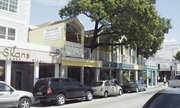By NEIL HARTNELL
Tribune Business Editor
nhartnell@tribunemedia.net
A Cabinet Minister yesterday told Tribune Business he “firmly believes” the City of Nassau Revitalisation Act will be extended beyond its end-June expiry, noting that to-date it had underpinned $18.8 million in tax concessions given to over $36 million in investment projects.
Indicating that the revival of Bay Street and the city of Nassau was among his key priorities, Khaalis Rolle, minister of state for investments, told this newspaper he was “very close” to creating a “template” or masterplan that would guide downtown’s redevelopment.
He said the goal was to “get the property owners that are able to go, going, and that means the Government will have to develop the template for it”.
Speaking earlier at a Bahamas Chamber of Commerce and Employers Confederation (BCCEC) luncheon, Mr Rolle emphasised that downtown Nassau’s revival hinged on a public-private sector partnership, with the Government creating “the enabling environment” and property owners/businesses providing the necessary investment capital.
As a start, he indicated that the 2008 City of Nassau Revitalisation Act, which expires at the end of June 2013, was likely to be renewed and extended by the Christie administration to spur the city’s further revival.
“The Act expires at the end of June,” Mr Rolle said. “However, the Government is actively considering the extension of the Act to initiate the revitalisation of the downtown area and surrounding environs.”
Speaking later to Tribune Business, Mr Rolle expressed confidence that the Cabinet would approve an extension of the Act, which allows raw materials and equipment needed to restore and upgrade downtown Nassau properties to be imported duty-free.
“I firmly believe it will be extended,” he added. Such remarks could provide the foundation for further investment, since it will reassure property owners and developers that government policy, and the tax concessions, will continue uninterrupted
Speaking to their importance, Mr Rolle told his Chamber audience: “The City of Nassau Revitalisation Act has granted concessions worth $18.8 million...... to a total capital expenditure exceeding $36 million.”
However, Larry Roberts, the Bahamas Realty chief executive, who is attempting to sell the $17.9 million Union Wharf property on behalf of the Thompson family, told the Minister that “height restrictions” were a major impediment to its purchase and redevelopment.
The four-acre Bay Street property, situated just east of the East Street junction, is a key to downtown Nassau’s successful redevelopment, but Mr Roberts said potential investors wanted “benchmarks” and “guidelines” as to the sort of development that would be permitted.
Mr Roberts added that Union Wharf, unlike the Kelly family-owned property (the former Betty K wharf), could not be re-developed for retail, meaning that condominiums, a condo hotel and/or marina were likely uses.
But, given the space limitations, the Bahamas Realty chief said the only way investors could earn a profit was to ‘build up’.
“We have had a number of people interested in it,” Mr Roberts said.
“But the first question they ask is: ‘How high can we build?’ Height restrictions are a major inhibitor to the redevelopment of that area.”
He added: “We’ve been saying to the prospects: ‘Tell us what you want, and we’ll see what we can do’. But they say: ‘We’re not going to spend money to put together a plan unless we have benchmarks to work with’. What can we tell investors, and can we have some guidelines to work with?”
In response, Mr Rolle acknowledged that the Town Planning Act had put in minimum standards, and called on Mr Roberts and his ‘prospects’ to “make a technical case” based on a plan - not just a idea - so that potential changes could be debated at the policy level.
Noting that the Kelly and Bethel families were well advanced with plans for their respective properties, Mr Rolle said: “The policymaking process can only be facilitated through actual plans.”
Pointing to the fact that any Union Wharf purchaser would have to ‘go vertical’ in its development, Mr Roberts added: “The Kelly property can be developed for retail, whereas this other property has to go vertical.
“What you can get per square foot is vastly different. How do you get money out of it?”
To which Mr Rolle responded: “Put me in a situation where I can make a case from a policy perspective.”
Meanwhile, Frank Comito, a senior executive with the Downtown Nassau Partnership (DNP), described the level of existing investment in downtown Nassau’s revitalisation as “$36 million and more to come”.
Noting the 1,000 feet of harbour boardwalk being developed just west of the Paradise Island bridge, along with an 100-slip marina and supporting facilities.
Mr Comito said the Cayman Islands-based Dart Group had just finished the redevelopment of the former BayParl Building on the corner of Bay and Parliament Streets, while the Pompey Museum and Square were set to re-open shortly, along with “a major transformation” of downtown Nassau’s sidewalks.
“It’s up to us to capitalise on the opportunities and what they present,” Mr Comito said.
Mr Rolle added that downtown Nassau’s redevelopment required “the concerted effort of both the Government and the private sector.
“The property owners have the ability to invest in their property, the Government has to create the enabling environment,” he said, adding that some projects and investment capital was “ready to go”.
The Government was “updating the masterplan for the look and feel of the City of Nassau, to ensure all the investments fit into that masterplan”.





Comments
Use the comment form below to begin a discussion about this content.
Sign in to comment
Or login with:
OpenID